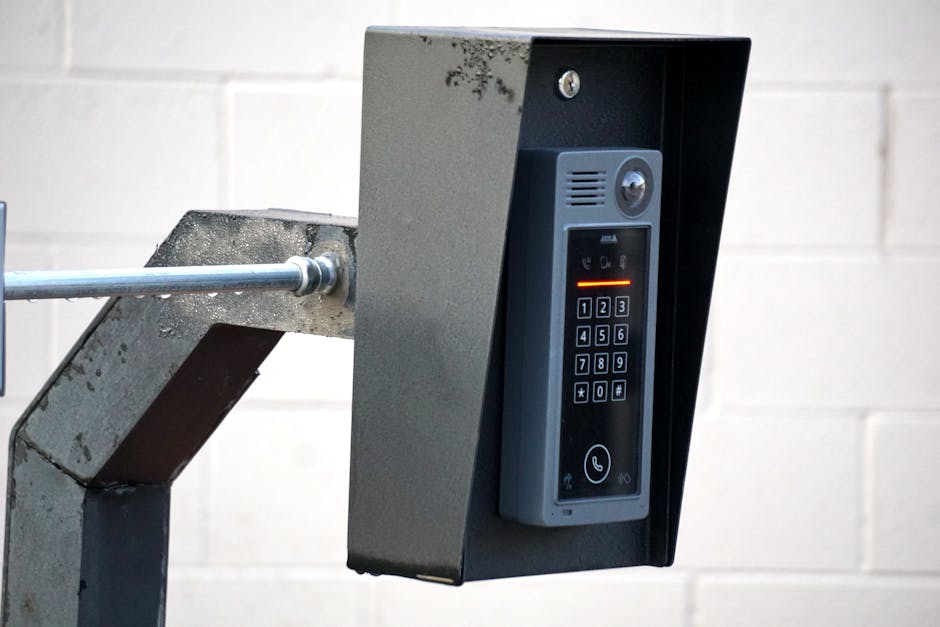The Ultimate Guide to Access Control Systems for Modern Workplaces
“Access control systems form the backbone of modern workplace security, determining who can enter physical spaces and access digital resources. This comprehensive guide explores different types of access control solutions, implementation strategies, and best practices to help corporate security managers create safer, more efficient work environments while protecting sensitive information and assets. ”

Understanding Access Control in the Modern Workplace
Access control is a fundamental element of security that formalizes who is allowed to access certain spaces, applications, data, and resources—and under what conditions. In today's interconnected workplace environments, implementing robust access control systems has become essential for organizations of all sizes to protect their physical assets, digital resources, and sensitive information.

The concept of access control extends beyond simply locking doors. Modern systems combine physical security measures with digital authentication methods to create comprehensive protection frameworks that safeguard both physical spaces and digital assets. For corporate HR managers, IT directors, facility managers, and educational institution administrators, understanding how to implement effective access control is crucial for maintaining security while enabling productivity.
Types of Access Control Systems
Access control systems come in various forms, each with distinct approaches to security management. Understanding these different types can help you choose the right solution for your organization's specific needs.
Discretionary Access Control (DAC)
Discretionary access control allows owners or administrators of protected resources to set policies defining who is authorized to access them. In DAC systems, the resource owner determines access permissions, which can be granted to specific users or groups. While this offers flexibility, a common criticism is the lack of centralized control, which can lead to inconsistent security policies across an organization.
Mandatory Access Control (MAC)
Mandatory access control implements security policies determined by a central authority based on security clearance levels. This highly structured approach is commonly used in government and military settings where information is classified by sensitivity levels. Users can only access resources if their security clearance matches or exceeds the classification level of the resource.
Role-Based Access Control (RBAC)
Role-based access control assigns permissions based on job functions or roles within an organization. Instead of granting access to individual users, RBAC systems assign access rights to specific roles, and users are then assigned to appropriate roles. This approach simplifies administration, especially in large organizations with frequent personnel changes, as permissions are tied to positions rather than individuals.
Attribute-Based Access Control (ABAC)
Attribute-based access control evaluates multiple attributes (user characteristics, resource properties, environmental conditions) to determine access permissions. ABAC offers greater flexibility by considering context—such as time of day, location, or device type—when making access decisions. This dynamic approach allows for more nuanced security policies that can adapt to changing circumstances.

Physical Access Control Components
Physical access control systems protect buildings, rooms, and other physical spaces from unauthorized entry. These systems typically include several key components:
Credentials and Authentication Methods
Modern access control systems use various credentials to verify identity:
-
Access cards and key fobs: These physical tokens contain embedded technology (magnetic strips, proximity chips, or smart card technology) that communicates with readers to grant access.
-
Biometric authentication: These systems verify identity using unique physical characteristics like fingerprints, facial recognition, iris patterns, or voice recognition. Biometric systems offer enhanced security as they're difficult to forge or transfer between users.
-
PIN codes: Personal Identification Numbers provide a simple authentication method, often used in combination with other credentials for multi-factor authentication.
-
Mobile credentials: Increasingly popular, these allow employees to use their smartphones as access tokens through secure apps, eliminating the need for physical cards.
Readers and Controllers
Access control readers scan credentials and send the information to controllers for verification. These range from simple card readers to sophisticated multi-factor authentication terminals. Controllers are the "brains" of the system, processing authentication data and determining whether to grant access based on programmed permissions.
Electronic Locks and Door Hardware
Various types of electronic locks work with access control systems:
- Electromagnetic locks use an electric current to create a magnetic force that secures doors
- Electric strikes replace traditional door strikes and can be remotely controlled
- Smart locks offer keyless entry with advanced features like temporary access codes and audit trails
Digital Access Control Solutions
As workplace management becomes increasingly digital, protecting information systems is just as important as securing physical spaces.
Identity and Access Management (IAM)
IAM systems manage digital identities and their access privileges across an organization's technology infrastructure. These platforms provide centralized control over user authentication, authorization, and privileges, making it easier to enforce security policies consistently across multiple systems and applications.
Single Sign-On (SSO) and Multi-Factor Authentication (MFA)
Single sign-on allows users to access multiple applications with one set of credentials, improving user experience while maintaining security. Multi-factor authentication requires users to provide two or more verification factors to gain access, significantly enhancing security by adding layers of protection beyond passwords.
Privileged Access Management (PAM)
PAM solutions provide enhanced control and monitoring for accounts with elevated privileges, such as administrator accounts. These systems help prevent unauthorized access to critical systems by implementing strict controls, session monitoring, and detailed audit trails for privileged users.
Implementing an Effective Access Control Strategy
Creating an effective access control strategy requires careful planning and consideration of your organization's specific needs and security requirements.
Conducting a Security Assessment
Before implementing any access control system, conduct a thorough assessment of your security needs:
- Identify valuable assets and sensitive areas that require protection
- Evaluate existing security measures and identify vulnerabilities
- Assess compliance requirements for your industry
- Determine the appropriate level of security for different areas and resources
Developing Access Policies
Clear access policies form the foundation of effective access control:
- Define who needs access to which resources and when
- Establish procedures for granting, modifying, and revoking access
- Create protocols for handling visitors, contractors, and temporary workers
- Document emergency access procedures
Integration with Other Security Systems
For maximum effectiveness, access control should be integrated with other security systems:
-
Video surveillance: Combining access control with video surveillance creates a powerful security solution that provides visual verification of access events.
-
Alarm systems: Integration allows automatic alarm activation when unauthorized access is detected.
-
Visitor management systems: These systems can issue temporary credentials and track visitor movements throughout your facility.

Best Practices for Access Control Management
Maintaining effective access control requires ongoing attention and adherence to best practices.
Regular Audits and Updates
- Conduct periodic reviews of access rights to ensure they remain appropriate
- Update access permissions promptly when employees change roles or leave the organization
- Test security measures regularly to identify and address vulnerabilities
- Keep all system components updated with the latest security patches
Employee Training and Awareness
Even the most sophisticated access control system can be compromised if users don't understand security protocols:
- Provide comprehensive training on security policies and procedures
- Educate employees about their role in maintaining security
- Create awareness about common security threats and prevention methods
- Encourage reporting of suspicious activities or security concerns
Balancing Security and Convenience
Finding the right balance between security and user convenience is crucial for successful implementation:
- Implement security measures proportionate to the sensitivity of protected resources
- Consider user experience when designing access control processes
- Use technology to streamline security procedures where possible
- Regularly gather feedback from users to identify and address pain points
Advanced Access Control Technologies
The field of access control continues to evolve with new technologies enhancing security and convenience.
Cloud-Based Access Control
Cloud-based systems offer several advantages over traditional on-premises solutions:
- Remote management capabilities allow administrators to control access from anywhere
- Automatic updates ensure systems remain current with the latest security features
- Scalability makes it easy to expand the system as organizational needs grow
- Reduced hardware requirements lower initial investment and maintenance costs
Mobile Access and Bluetooth Technology
Mobile access solutions are transforming how we approach access control:
- Smartphone-based credentials eliminate the need for physical cards or fobs
- Bluetooth Low Energy (BLE) technology enables hands-free access
- Mobile credentials can be issued, modified, or revoked instantly
- Enhanced user experience with familiar technology
AI and Machine Learning Applications
Artificial intelligence and machine learning are bringing new capabilities to access control:
- Behavioral analytics can detect unusual access patterns that may indicate security threats
- Predictive capabilities help identify potential vulnerabilities before they're exploited
- Automated responses to security incidents reduce reaction time
- Continuous system optimization based on usage patterns and security events
Compliance and Regulatory Considerations
Access control systems must often meet specific regulatory requirements, particularly in industries handling sensitive information.
Industry-Specific Regulations
Different industries face various regulatory requirements that impact access control:
- Healthcare: HIPAA requires safeguards for protected health information
- Finance: PCI DSS mandates controls for cardholder data
- Education: FERPA protects student records and requires appropriate access controls
- Government: Various regulations govern access to classified information and facilities
Data Privacy Concerns
With increasing focus on data privacy, access control systems must be designed with privacy protection in mind:
- Collect only necessary personal information for authentication
- Implement appropriate safeguards for stored credential data
- Ensure compliance with privacy regulations like GDPR or CCPA
- Provide transparency about how user data is collected, stored, and used

The Future of Access Control
As technology continues to advance, access control systems are evolving to meet new challenges and opportunities.
Contactless and Touchless Solutions
The COVID-19 pandemic accelerated the adoption of contactless access technologies:
- Facial recognition systems that work with masked individuals
- Gesture-based controls that eliminate the need to touch shared surfaces
- Voice-activated systems for hands-free operation
- Long-range readers that authenticate users from a distance
Integration with Smart Building Technology
Access control is becoming a key component of smart building ecosystems:
- Integration with building automation systems for enhanced efficiency
- Occupancy monitoring to support space optimization and energy management
- Environmental controls that adjust based on occupancy patterns
- Improved emergency response through coordinated building systems
Decentralized Identity and Blockchain
Emerging technologies are creating new possibilities for secure identity verification:
- Blockchain-based credentials that enhance security and privacy
- Self-sovereign identity solutions that give users control over their identity information
- Decentralized authentication that reduces reliance on central authorities
- Enhanced interoperability between different access control systems
Conclusion: Creating a Secure and Efficient Workplace
Implementing effective access control is essential for creating a secure, efficient, and compliant workplace environment. By understanding the various types of access control systems, carefully planning your implementation strategy, and staying current with emerging technologies, you can develop a comprehensive security approach that protects your organization's assets while supporting productivity and user satisfaction.
Remember that access control is not a one-time implementation but an ongoing process that requires regular assessment and adaptation to address evolving security threats and organizational needs. With the right combination of technology, policies, and user education, you can create a secure environment that supports your organization's mission and protects its most valuable assets.
By taking a strategic approach to access control, facility managers, IT directors, and security professionals can create safer, more efficient workplaces that protect both physical and digital resources while enabling the workflow optimization necessary for business success in today's competitive environment.